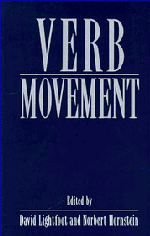Book contents
- Frontmatter
- Contents
- List of contributors
- Preface
- Verb movement: an introduction
- 1 Verb positions: evidence from Italian
- 2 Verb movement and word order in Arabic
- 3 Comments on the paper by Ouhalla
- 4 Some similarities and differences between Icelandic and Yiddish
- 5 Comments on the paper by Santorini
- 6 Finite verb movement in Scandinavian embedded clauses
- 7 Comments on the paper by Vikner
- 8 The Brythonic copula and head raising
- 9 A reinterpretation of evidence for verb movement in French
- 10 Two types of head movement in Romance
- 11 Comments on the paper by Roberts
- 12 Licensing heads
- 13 Comments on the paper by Koopman
- 14 Finiteness and head movement in early child grammars
- 15 Comments on the paper by Wexler
- References
- Index
10 - Two types of head movement in Romance
Published online by Cambridge University Press: 03 May 2011
- Frontmatter
- Contents
- List of contributors
- Preface
- Verb movement: an introduction
- 1 Verb positions: evidence from Italian
- 2 Verb movement and word order in Arabic
- 3 Comments on the paper by Ouhalla
- 4 Some similarities and differences between Icelandic and Yiddish
- 5 Comments on the paper by Santorini
- 6 Finite verb movement in Scandinavian embedded clauses
- 7 Comments on the paper by Vikner
- 8 The Brythonic copula and head raising
- 9 A reinterpretation of evidence for verb movement in French
- 10 Two types of head movement in Romance
- 11 Comments on the paper by Roberts
- 12 Licensing heads
- 13 Comments on the paper by Koopman
- 14 Finiteness and head movement in early child grammars
- 15 Comments on the paper by Wexler
- References
- Index
Summary
Introduction
The basic point of this paper is to argue that there are two distinct kinds of head movement. One kind is triggered by morphological properties of the host head, while the other kind is not, and in fact often appears to be triggered by some property of the moved head. Adopting and extending the terminology of Chomsky & Lasnik (1991), we refer to the former as L-related head movement and the latter as non-L-related head movement.
Both types of head movement are subject to the ECP, but, since the nature of the target of movement is different in each case, the antecedent-government requirement manifests itself in different ways. This gives the appearance of differing locality conditions; in particular, only L-related head movement obeys the “classical” Head Movement Constraint of Travis (1984). By a revision of the Relativized Minimality Condition of Rizzi (1990b), however, we see that both the cases which obey this condition and those which do not are in conformity with the ECP.
We assume a conjunctive formulation of the ECP, as in Rizzi (1990b: chapter 2). Moreover, we assume that traces of head movement are subject to a uniform head-government requirement. For non-L-related head movement, this raises the possibility that the head-governor and the antecedent-governor may be distinct. Our main empirical argument for the framework to be adopted relies on this fact; we will show that there is diachronic evidence from French that non-finite AGR ceased to be a head-governor for head traces in the 17th century, with the result that a number of instances of non-L-related head movement disappeared together.
- Type
- Chapter
- Information
- Verb Movement , pp. 207 - 242Publisher: Cambridge University PressPrint publication year: 1994
- 44
- Cited by

